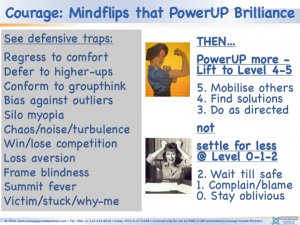 If you’re an innovation leader who’s been asked to build a strategy that can take a product, technology, alliance or service to a new level of value-creation – or transform a line of business to stay competitive in a volatile uncertain complex aggressive (VUCA) market – don’t be surprised when your Courage is tested along with your intellect, creativity and business acumen.
If you’re an innovation leader who’s been asked to build a strategy that can take a product, technology, alliance or service to a new level of value-creation – or transform a line of business to stay competitive in a volatile uncertain complex aggressive (VUCA) market – don’t be surprised when your Courage is tested along with your intellect, creativity and business acumen.
According to this WSJ article by a partner at Deloitte, who plays a key role in their Canadian strategy practice, there are 3 moments of truth when it takes Courage to lift a team from settling for safe don’t-rock-the-boat, me-too, tweak-what-we-always-did possibilities – and propose something that is truly transformative. At these moments of truth, Innovation Leaders can choose what is safe, easy, conventional or politically expedient – or can choose what Deloitte called, “…willingness to engage in courageous conversations, to spark courageous considerations, and to make and execute courageous choices.”
If the conversations, considerations and choices that PowerUP innovation thinking were easy – it wouldn’t take Courage. But they’re not. Even when your board, your senior management, your alliance partners or key customers ask for a disruptive breakthrough, it doesn’t mean that they are eager to put aside their routines, biases and preconceptions or co-create with you. Or that they’ll be eager to share or surrender hegemony, if your very best Big Idea asks them to follow someone else’s thought-leadership. Or look beyond “what the big boss wants you to do.”
Finding your own Courage is one challenge for innovation and strategy leaders. Building Courage in a board, C-suite leaders, investment analysts is harder. Infusing Courage into the DNA of a complex diverse matrix of payers, users and co-creators is harder still – both inside your own enterprise and inside a customer’s and supplier’s enterprise. Yet, without lifting your everyone’s Courage, important conversations get avoided, important considerations get ignored and choices get made by default or drift or by overcommitting to too many ideas, which ensures that nothing will be decided or done.
In our Innovation Leadership practice, we’ve identified 12 defensive traps which Innovation Leaders have to anticipate – and address, both prophylactically and in real-time – to transform easy politically expedient conversations, considerations and choices into Level 5 courageous conversations, considerations and choices. When we prepare Innovation Leaders to orchestrate strategy-formulation and strategy-execution Innovation Initiatives, we dramatize these 12 defensive traps with fun vivid games, dramatized case studies, practice scenarios – and we give Innovation Leaders a North-South-East-West-Centre roadmap, to lift deliberations and decisions to Level 4-5 possibility thinking.
With practice, we see Innovation Leaders infuse Courage into the DNA of the teams they mobilize and orchestrate. Until, eventually, Level 5 thinking requires an occasional burst of power to sustain  altitude in turbulence, rather than a heavy lift to get off the runway. In that respect, Courage is a paradox. When you need it most, because headwinds and crosswinds blow in a different direction, it’s hardest to do – whether you are the CEO calling teams to action or the visionary in the middle of the matrix who sees better possibilities and is mobilizing thought-partners and co-developers. And that, precisely, is when strategy-building and breakthrough innovation are most important for enterprise success. If you are willing and able to diagnose and intervene, to lift out of victim-thinking, groupthink, summit fever, bias against creativity, loss aversion, hierarchy dependence and other defensive traps in your conversations, considerations and choices.
altitude in turbulence, rather than a heavy lift to get off the runway. In that respect, Courage is a paradox. When you need it most, because headwinds and crosswinds blow in a different direction, it’s hardest to do – whether you are the CEO calling teams to action or the visionary in the middle of the matrix who sees better possibilities and is mobilizing thought-partners and co-developers. And that, precisely, is when strategy-building and breakthrough innovation are most important for enterprise success. If you are willing and able to diagnose and intervene, to lift out of victim-thinking, groupthink, summit fever, bias against creativity, loss aversion, hierarchy dependence and other defensive traps in your conversations, considerations and choices.

